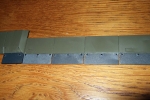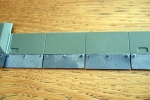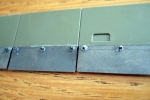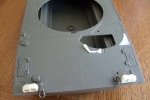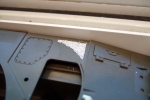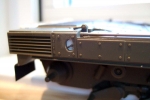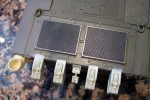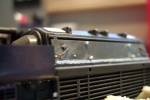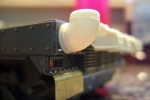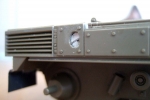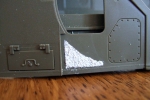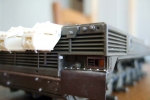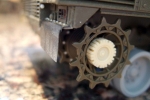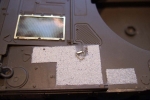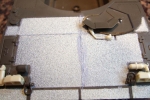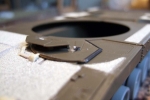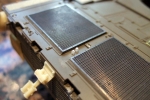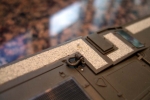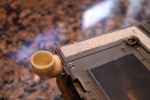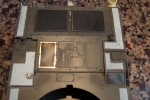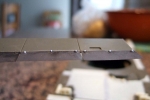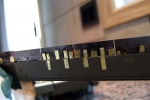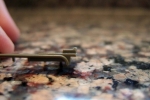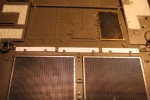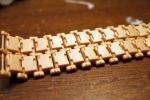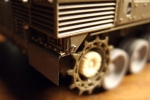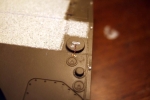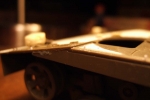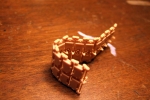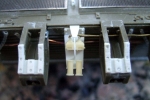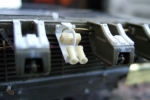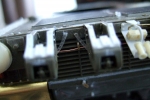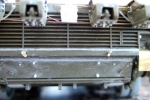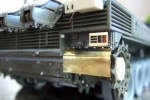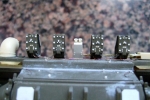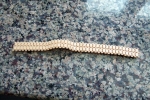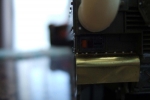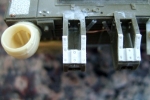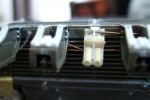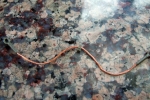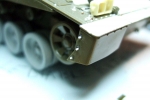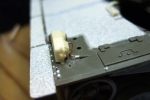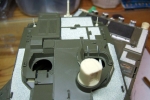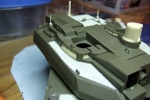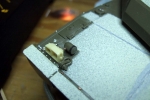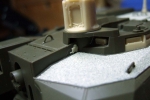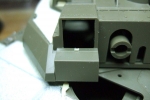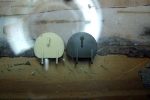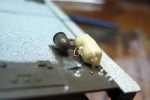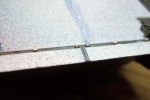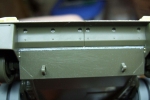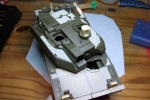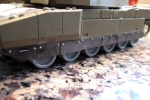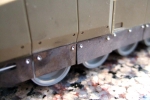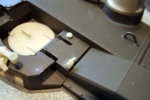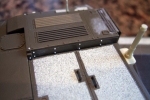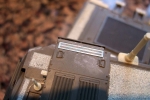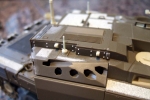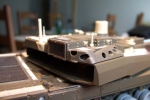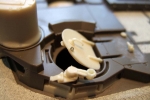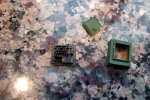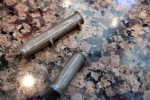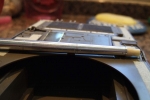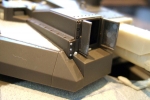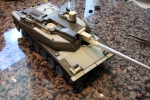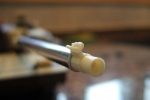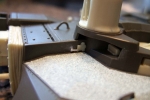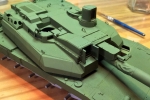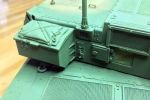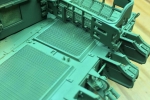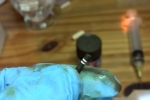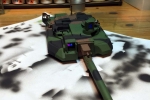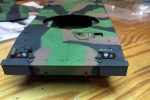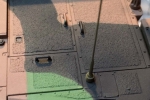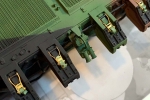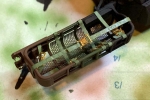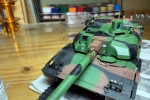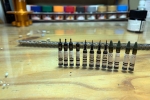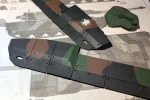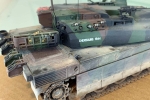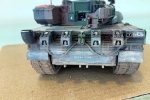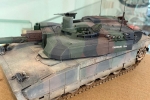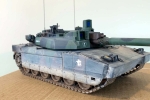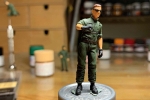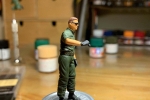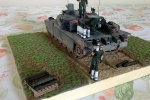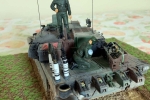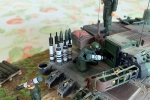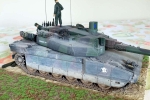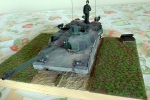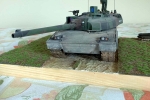1⁄35Leclerc Project
14
Comments
Introduction
After 7 years in the works, I have completed my Leclerc project. This has been the most formative modeling project I have ever done, as most techniques or products used, such as PE and resin, were new to me. The Leclerc tank has always fascinated me; as most french afv’s tend to have particularities that makes them stand out from their other equivalents, such as the use of a gas turbine to act as a turbo or a compressed air system in lieu of a bore evacuator. Although not fielded in a combat role by France, it gained good reputation in combat from UAE army’s, when it received its trial by fire during the Yemini civil war. The subject depicted here is a Series 2 tank, which is an improvement over the Series 1 vehicles. The most recognizable feature is the addition of an A/C unit on top of the turret. Other improvements include better electronics and thermal imaging systems and integration of battle management systems. The kit is made by Tamiya and is the first edition of the kit, which included die-cast wheels, that came already primed in the box. Later on Tamiya re-edited it with standard plastic wheels. The model in itself is representative of Tamiya’s usual quality regarding fitment, ease of part cleaning and assembly. While the basic geometry is respected, it lacks many details and lots of corners were cut. Fortunately, a fellow modeller, Olivier Carneau, published a complete guide, showcasing step by step every details that needed to be corrected if you want an accurate model. This document guided me during the whole building process and made the project more feasible, as it gave me sequenced objectives to attain, just like in a regular assembly document.Kit Add Ons
Additionally, the kit was paired with various aftermarket add-ons that not only saves you time, but corrects parts that are wrongfully represented in the kit. They are optional, but highly recommended: - Voyager PE update set o Includes a metal barrel plus several resin parts, a must-have for the kit. - Blast models Leclerc update set o Although quite pricey, the set is extensive and has fine details and a high part count. The most notable improvements over the basic kit are the commander’s panoramic sight and the external fuel drums supports. Highly recommended. - Blast models Galix set o Contains multiple Galix 80mm smoke and HE frag ammo for the turret plus the launchers caps. You get to choose between two configurations: smoke only or smoke + HE frag. Tamiya’s kit only gives you basic launching tubes. Recommended. - Eduard PE set o A good supplement to the Voyager set, it was used in conjunction and as an alternative. - Eduard side skirt PE set o Appears to be out of production, it is a nice addition as the plastic molded rubber flaps on the skirts are too thick. Eduard included a bracket system to mount the panels and has a good representation of the cutter pins used to attach the panels. E.T. model offers a complete PE set that seems to include these parts, so it could be an alternative to look for. - Bronco tracks o Tedious to assemble, and needs extra care to avoid links getting glued by capillarity. I ended up buying two sets as many links were indeed glued and unmovable. - Echelon decals o Gives you options for RT5 (retrofitted series 1) and T6 (Series 2) markings, plus additional vehicle plates, letters and numbers to create your own. Highly recommended. - Orange hobby French afv antenna set o The bases are really detailed, but the antennas themselves are too thick and too short. The model was to be represented on a diorama, so figures, shells and shell containers from blast models were added to the project. One specific figure is represented holding a 120mm shell during a reloading sequence; blast includes a basic reloading mechanism along with a new trapdoor. Requires a bit of surgery but adds originality and extra details to the kit.The Build
Hull basic detailing The construction began with the basic assembly of the hull. Blast model’s parts were added along and are “glue and forget”. The anti-slip texture is represented in the kit but is too soft in details. On the positive side, it gives you rough guide-lines to follow. I tried to use Vallejo white pumice first, but the texture was too thick and out of scale. I then chose to use Rustoleum textured paint. To me the result was spot on. You need good markings as to not overspray and go by thin layers. Weld beads were then added using Tamiya putty. Basic PE details were added on the hull, such as intake grills. Scratched details includes a lot of bolts, grab handles and stops near the power pack access trap (the handles were inserted in brass tubing), towing loops and plates. Voyager and Eduard included PE parts for the fenders, but were too rigid and thick. I ended up making them myself using thinner brass sheet, adding the steel mounting plate on top along with the bolts. One nice addition that was made to the original model was the infantry telephone access door on the side of the tank. It is represented by Tamiya but lacks any depth. The plastic was drilled and a back plate added inside the hull. A weld bead on its contour was made using miliput, and the grab handle installed with a PE part from Eduard set. Details were added to the driver’s hatch; you need both Voyager’s and Eduard’s set at this stage to add the missing rubber flaps surrounding the hatch. PE was used for the crank handle, supplemented by scratch details using Plastruct rods. Detailing the rear Lots of details were added to the rear of the tank. An accident happened when gluing in place the external fuel drums supports and I had to scrap one of them. I decided to remove them all, take the simplified ones from Tamiya and add details. It was a tedious task to do, adding the rubber shoes, drilling them, adding bolts in each holes and add the ribbed texture. Blast model’s made an error regarding the fuel port connectors. Its mounting plate is the same as the kit, which in turn is not the correct one for a Series 2 tank. It was re-made from plastic sheet. Wiring and grounds were added, rubberized housing was made with Maskol. Simple brackets for the wiring were made with thin brass sheet and bolts were added on them. Detailing the front The front of the tank received various upgrades too, including nice resin headlights made by Blast, supplemented with copper wiring. The horn received its protective wrap, made out of spare mesh from previous Tamiya kits. Support rods were added for the NBC decontaminator, and a plethora of copper tie downs. The skirts received attention too, and instead of using Eduard’s flimsy rubber side panel PE mounting brackets, I used long strips of brass sheet to mount each panel. Every panel has 3 holes with a mounting axle made out of 0.5mm platruct rod, with a PE cutter pin. The last panel of the side skirts was removed as often seen on the real tanks for easier access to the drive sprocket. Turret assembly and detailing Assembly of the turret was much more straightforward as blast addresses most of what needs to be corrected on the kit. One part was re-worked, which is the co-ax mg vent port underneath the crew commander panoramic sight. The Leclerc turret has two fiberglass reinforced panels on the side of the turret neck. Such texture was obtained using wood glue and fine, long, grass used for railway modeling. Cut to length and glued in a way to represent the overlapping fibers, the result was very realistic. Most of the detailing went in this area of the turret; as the tank was going to be represented in a reloading sequence, the turret basket had to be positioned opened, which leaves an area not covered by Tamiya at all. Hopefully, Eduard included a basic PE basket securing system. Surgery had to be done to install blast’s reloading mechanism. I went a bit far by drilling the hinges of the included trap door and using small copper wire bits to make axles, so the trap door could be movable. The same was done to the turret basket hinges, and a locking arm (also moveable) was added to realistically secure the basket in place while in the open position. The basket grill does not come from Voyager PE set, as it had bend zones that made the part too geometrical. A whole PE sheet from Aber was taken for this part and bent by hand. The holes are slightly oversized but the end result is still better. The gunner sight and crew commander panoramic sight received pink and purple plastic confetti to imitate the reflective coating on the glass. Painting and assembly of final details. Basic painting was done using XF1 flat black, XF5 flat green and XF64 red brown. Masking was made using bluetac. Tamiya made some errors regarding the camo scheme, so my advice would be to use reference pictures to double check. The antennas were put in place during this phase. Only the bases were kept from Orange hobby’s set, and the antenna was made using guitar string glued with CA. The bond is fragile so extra care was taken when manipulating these. One of the final challenge in the assembly was the voyager’s pe ratchets for the external fuel drums straps and turret basket. It was a tedious job to do, but patience is key here and it paid off as they are on point detail wise. Support arms for these ratchets were made with plastic sheet and the straps were made using painted masking tape. One sketchy thing was to loop them in the turret basket slots; again, patience is key. Weathering One big accident happened when I tried varnish my model. That was my fault; I didn’t used the same brand for my thinner and varnish and it had an orange peel end result on my model. I wasn’t sure of the type of weathering I wanted to go with at first, but the varnish obligated me to give the model a dusty and muddy look in order to hide most of the orange peel effect. After Echelon’s decals were applied, I used AK’s wash for NATO vehicles. For the tracks, I used AK’s plaster base with enamel based fresh mud effect to create a dried and crumbled mud texture on both the tracks and the wheels. Pigments, sometimes mixed with water, were used extensively on the main hull, and side skirts but less on the turret. The drive sprockets had their teeth silvered using AK’s weathering pencils. Fuel stains and engine grime were sparsely added over the dust pigments, giving small areas of the model the impression that fuel and oil made a light crust with dust and dirt. Diorama The base for the diorama consist of a grass mat made by model scene. I’m highly satisfied by the realism and the ease of use of this product. The mat was cut to size and glued on a wood base. The trail in the middle was made using Vallejo white pumice and then painted with Tamiya buff and red brown. The 120mm shells from blast set consists of APFSDS, HE and HEAT projectiles. The most challenging part was to paint the black stripes on them. For the APFSDS shells, I used needle tips cut to length instead of the resin parts to have a straighter and more realistic end result. The wood pallet comes from a pallet lift kit that I got as a gift for placing an order online. It’s made out of real wood so this is a plus that I’m happy to include in my diorama base. I added goggles for the crew commander and gunner helmets, using spare parts from other Tamiya figures. The straps are homemade using masking tape.Conclusion
I am very happy with the end result. The accident with the varnish gave me an opportunity to be more creative with the weathering process and I was careful to not exaggerate it, even if I knew that in the end I was going to make a dirty vehicle anyway. One thing that I would’ve liked to do differently, would be to use masking putty instead of blue tac as it was sometimes complicated to do the camo scheme. It turned out good, but I had to repaint certain areas because it left oily deposits or lifted the paint underneath. I’m quite proud of everything this project made me learn and I hope it’s going to serve me well in my subsequent projects.Comments
Great build!! I love the weathering on the hull!!
You may want to research ammo stowage/handling. You'd never see rounds on a tank like that.
JUL 29, 2020 - 06:59 AM
Thank you all for your kind comments ! Really appreciated.
I've done my research, no worries


JUL 29, 2020 - 09:14 AM
My apologies.
Those guys are asking to be put in the forum topic about follies and accidents.
9V and those go boom.
JUL 29, 2020 - 11:46 AM
Did I miss what you used for a texture treatment on the no slip surfacing? Please share.
AUG 03, 2020 - 07:03 AM
Wow, great diorama. And...great Leclerc! I love that tank! I have 2 of them, both are the cast raid wheel versions, and I have the Blast resin set and an Eduard PE set for both of them, and one set of Bronco tracks. So it looks like I've got everything that was used in this project. Will I be able to get even close to as goos as this??
I'd started one of these many years ago, but I only got maybe 20% along. The other kit is still sealed in its original cellophane. But I LOVE this tank, and I have, printed out and in with the instructions, the detailed 'manual' that Olivier put together to make this tank as accurate as possible, AND a Leclerc book. So, I am WAY ready to build not one, but TWO, Leclercs, at some point, once I head back to armor from the airplane jag I've been on for the last 2 years or so. But I'm really impressed with your tank, and I"m sure I'll be able to take some guidance from your build. Really nice work!!!
SEP 03, 2020 - 09:38 AM
amazing work!!!!!
Really well done, and nice job, I will have to at some point build one of these. It's been on my list, but I always come across something else in the stash to build instead. Regardless the weathering, the scratch mat building and the attention to detail are incredible.
NOV 27, 2020 - 04:26 PM
Copyright ©2021 by Tom. Images and/or videos also by copyright holder unless otherwise noted. The views and opinions expressed herein are solely the views and opinions of the authors and/or contributors to this Web site and do not necessarily represent the views and/or opinions of Armorama, KitMaker Network, or Silver Star Enterrpises. All rights reserved. Originally published on: 2020-07-28 15:37:07. Unique Reads: 6812





